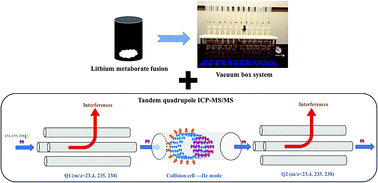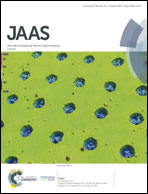Rapid determination of uranium isotopes in calcium fluoride sludge by tandem quadrupole ICP-MS/MS
Abstract
Quantitative analyses of potential radionuclide contaminants in solid wastes (e.g. calcium fluoride sludge) generated by the nuclear industry are essential for clearance or reutilization of these wastes. In order to measure trace uranium isotopes in calcium fluoride sludge, a total sample dissolution method was developed utilizing lithium metaborate fusion and anion exchange chromatography combined with a triple quadrupole ICP-MS/MS instrument. The method was validated using calcium fluoride sludge spiked with known amounts of uranium isotopes. All measured results were in good agreement with the expected values, demonstrating the feasibility of the method for the determination of trace uranium isotopes. The minimum detectable activities of 234U, 235U and 238U were determined to be 0.15 mBq (0.65 pg), 0.67 μBq (8.38 pg) and 0.014 mBq (1.13 ng), respectively. A key finding was that the sensitivity of uranium (750 Mcps ppm−1) with He at a flow rate of 8.5 mL min−1 was 5 times that achieved by ICP-MS/MS without the collision gas. The investigation of the mechanism of He collision would provide a novel and optimal method to simultaneously improve the sensitivity and suppress interference for the analysis of ultra-low level heavy radionuclides (e.g., uranium, plutonium, and americium) combined with reaction gasses (e.g., CO2, O2, and NH3).



 Please wait while we load your content...
Please wait while we load your content...